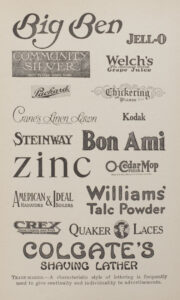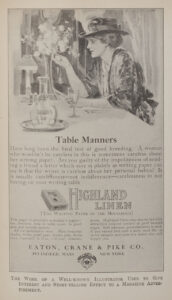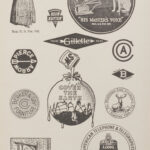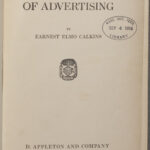Published: New York and London, 1915
These days we recognize advertising as big business: thirty-second Superbowl spots sell for eye-popping amounts each year. And it’s hard to deny that advertising is effective: just glimpsing the logo of a favorite junk food brand can create a hankering that’s positively Pavlovian.
There’s a science behind successful advertisements, which the author of today’s book, Earnest Elmo Calkins (1868-1964), attempts to explain. As he states in the foreword, it is through “scientific management, the painstaking collection of statistics and their intelligent arrangement, and the exercise of … common-sense” that we reduce the “element of uncertainty in the launching of an advertising campaign.”
 Calkins, who with Ralph Holden formed Calkins and Holden, a leading American advertising firm in the early 20th century, was himself an advertising pioneer. Notably, he devised a theory of “consumer engineering” stating that effective advertisements and designs could create an artificial demand for a product. Manufacturers could increase demand even further through planned obsolescence.
Calkins, who with Ralph Holden formed Calkins and Holden, a leading American advertising firm in the early 20th century, was himself an advertising pioneer. Notably, he devised a theory of “consumer engineering” stating that effective advertisements and designs could create an artificial demand for a product. Manufacturers could increase demand even further through planned obsolescence.
Sure enough, our society has changed: once upon a time, we’d buy a product to use it for as long as possible. Now we buy a product to use it for a period of time and then replace it with a new one, only to replace that one in turn, in a continuous cycle of consumerism.
Calkins was also an early proponent of the “soft sell.” Soft sell advertising, as its name suggests, is a less aggressive sales approach, intended to promote sales through indirect suggestion. The method requires that the advertiser pay close attention to the consumer’s desires and needs, and build a relationship of trust between consumer and manufacturer.
Calkins’ firm made a practice of going door-to-door and speaking with housewives to improve the effectiveness of advertisements. He also condemned, in writing, what he considered the unsavory practices of other advertisers, including the use of fear, pseudoscientific jargon, and paid testimonials.
If the advertisements that illustrate this book now strike us as kitschy and nostalgic, it’s at least partly the result of today’s ad campaigns, which are so much more sophisticated … having evolved from Calkins’ own early ideas.




